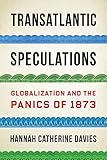Transatlantic Speculations : Globalization and the Panics of 1873 / Hannah Catherine Davies.
Material type: TextPublisher: New York, NY : Columbia University Press, [2018]Copyright date: ©2018Description: 1 online resourceContent type:
TextPublisher: New York, NY : Columbia University Press, [2018]Copyright date: ©2018Description: 1 online resourceContent type: - 9780231185561
- 9780231546218
- HB3717 1873 .D38 2018
- online - DeGruyter
- Issued also in print.
| Item type | Current library | Call number | URL | Status | Notes | Barcode | |
|---|---|---|---|---|---|---|---|
 eBook
eBook
|
Biblioteca "Angelicum" Pont. Univ. S.Tommaso d'Aquino Nuvola online | online - DeGruyter (Browse shelf(Opens below)) | Online access | Not for loan (Accesso limitato) | Accesso per gli utenti autorizzati / Access for authorized users | (dgr)9780231546218 |
Browsing Biblioteca "Angelicum" Pont. Univ. S.Tommaso d'Aquino shelves, Shelving location: Nuvola online Close shelf browser (Hides shelf browser)

|

|

|

|

|

|

|
||
| online - DeGruyter Sisters of the Cross / | online - DeGruyter Open to Reason : Muslim Philosophers in Conversation with the Western Tradition / | online - DeGruyter The Conflicted Superpower : America's Collaboration with China and India in Global Innovation / | online - DeGruyter Transatlantic Speculations : Globalization and the Panics of 1873 / | online - DeGruyter Raising China's Revolutionaries : Modernizing Childhood for Cosmopolitan Nationalists and Liberated Comrades, 1920s-1950s / | online - DeGruyter At Home in the World : Women and Charity in Late Qing and Early Republican China / | online - DeGruyter The Duplicity of Philosophy's Shadow : Heidegger, Nazism, and the Jewish Other / |
Frontmatter -- CONTENTS -- ACKNOWLEDGMENTS -- INTRODUCTION -- CHAPTER 1. SETTING THE STAGE CHAPTER 1 SETTING THE STAGE -- CHAPTER 2. THE VIRTUAL WORLD OF FINANCIAL INFORMATION AND THE MAKING OF A BUBBLE -- CHAPTER 3. PREDICTING AND EXPERIENCING THE PANICS OF 1873 -- CHAPTER 4. FLOWS OF PAPER, FLOWS OF GOLD -- CHAPTER 5. CAPITALISM, CONSPIRACY, CORRUPTION, AND THE MORAL ECONOMY OF A FINANCIAL CRISIS -- CHAPTER 6. CRIMINALIZING PROMOTERS, PROTECTING SHAREHOLDERS -- CONCLUSION -- NOTES -- BIBLIOGRAPHY -- INDEX
restricted access online access with authorization star
http://purl.org/coar/access_right/c_16ec
The year 1873 was one of financial crisis. A boom in railway construction had spurred a bull market-but when the boom turned to bust, transatlantic panic quickly became a worldwide economic downturn. In Transatlantic Speculations, Hannah Catherine Davies offers a new lens on the panics of 1873 and nineteenth-century globalization by exploring the ways in which contemporaries experienced a tumultuous period that profoundly challenged notions of economic and moral order.Considering the financial crises of 1873 from the vantage points of Berlin, New York, and Vienna, Davies maps what she calls the dual "transatlantic speculations" of the 1870s: the financial speculation that led to these panics as well as the interpretative speculations that sprouted in their wake. Drawing on a wide variety of sources-including investment manuals, credit reports, business correspondence, newspapers, and legal treatises-she analyzes how investors were prompted to put their money into faraway enterprises, how journalists and bankers created and spread financial information and disinformation, how her subjects made and experienced financial flows, and how responses ranged from policy reform to anti-Semitic conspiracy theories when these flows suddenly were interrupted. Davies goes beyond national frames of analysis to explore international economic entanglement, using the panics' interconnectedness to shed light on contemporary notions of the world economy. Blending cultural, intellectual, and legal history, Transatlantic Speculations gives vital transnational and comparative perspective on a crucial moment for financial markets, globalization, and capitalism.
Issued also in print.
Mode of access: Internet via World Wide Web.
In English.
Description based on online resource; title from PDF title page (publisher's Web site, viewed 29. Mrz 2022)


